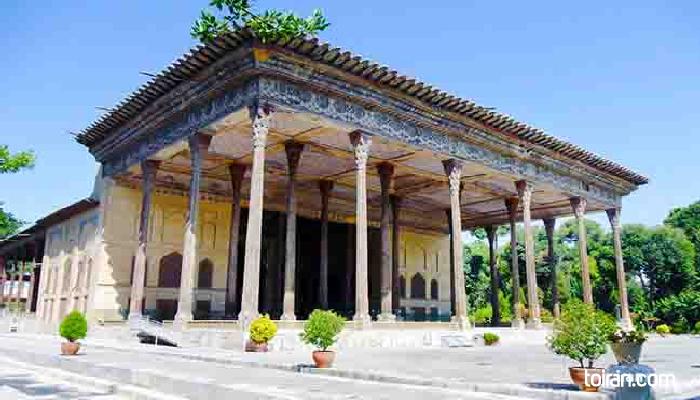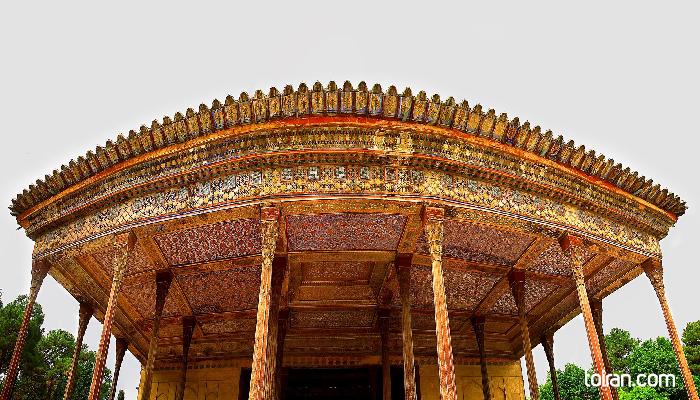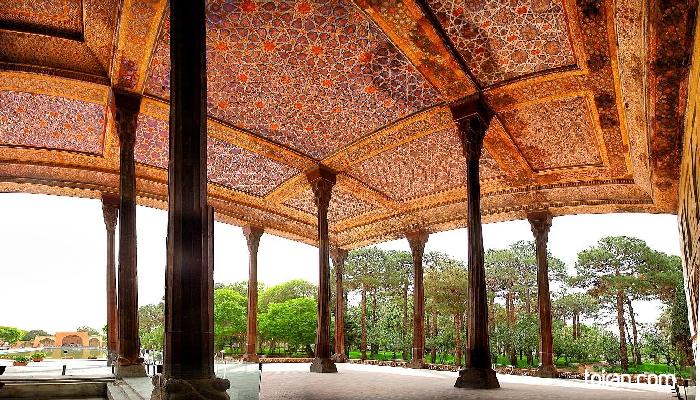Chehel Sotoun (40 columns) Pavilion in Isfahan was built by Safavid monarch Shah Abbas I (1571-1629) inside a large garden in a 67,000-square-meter area. Shah Abbas II (1632-1666) completed the pavilion, made further additions to it and commissioned its elaborate exterior and interior decorations.
Like the palaces of Persepolis, the Chehel Sotoun Pavilion stands on a platform above the ground. This pavilion is a combination of Persian, Chinese and Western architecture and is one of the first monuments in which extensive mirrorwork, wall paintings, wooden columns with moqarnas column heads were used. All walls in this pavilion were once covered in full-length mirrors and doors and windows had monabbat (wood carving and inlaid work) and khatam (marquetry) decorations.
Once used as a reception hall for foreign emissaries, the pavilion has a main terrace that opens to the garden. This terrace is 3 meters long and 17 meters wide and has 20 columns made of plane and pine wood. These columns were originally adorned with mirrorwork and colored wooden decorations.
There is a rectangular pool, which is 110 meters long and 16 meters wide, with water fountains in front of the terrace. There were once four stone lion fountains which poured water into the central pool from each corner. The terrace columns are doubled when reflected in the pool creating the illusion of 40 columns, which the pavilion has been named after.
The main hall of the pavilion, where foreign guests were entertained contains frescoes depicting specific historical scenes, military exploits and court life. There are Persian miniature paintings below these frescos.
Some of the scenes depicted in these frescos include the reception of Mughal Emperor Humayun (1508-1556) by Tahmasp I (1514-1576), the battle of Shah Ismail I (1487-1524) and Ottoman Selim I (1465-1520) at Chaldoran, Shah Abbas I receiving Vali Muhammad Khan (reign 1605–1611) from the Khanate of Bukhara, Shah Abbas II receiving Nadir Muhammad Khan (reign 1642–1645) from the Khanate of Bukhara, the Battle of Karnal and the victory of Nader Shah Afshar (1688-1747) over Muhammad Shah Rangeela (1702-1748), and the battle and victory of Shah Ismail I over Muhammad Shaybani Khan (1451-1510). The scenes of Karnal and Chaldoran are believed to have been added to the building in the Qajar era (1785 -1925).
The works of Dutch painters such as Philips Angel van Leiden (1618-1664) can be seen in parts of the palace.
There was once a precious Quran above the main entrance of the pavilion, which ensured anyone passing from under the entrance would be blessed by the Holy Book and travel safely. The Quran has since been moved to the museum inside the palace.









It feels amazing to walk in the beautiful garden here by the water and the palace itself is an amazing structure. the location is in a walking distance from major tourist attraction site such as Naqshe Jahan Sq.